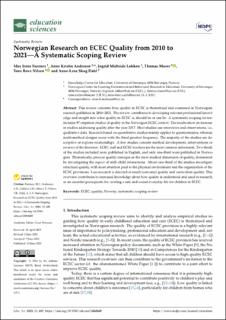| dc.contributor.author | Furenes, May Irene | |
| dc.contributor.author | Andresen, Anne Kristin Hansen | |
| dc.contributor.author | Løkken, Ingrid Midteide | |
| dc.contributor.author | Moser, Thomas | |
| dc.contributor.author | Nilsen, Tone Rove | |
| dc.contributor.author | Dahl, Anne-Lene Skog | |
| dc.date.accessioned | 2023-12-04T09:55:42Z | |
| dc.date.available | 2023-12-04T09:55:42Z | |
| dc.date.created | 2023-06-19T13:06:57Z | |
| dc.date.issued | 2023 | |
| dc.identifier.citation | Furenes, M. I., Andresen, A. K., Løkken, I. M., Moser, T., Nilsen, T. R., & Dahl, A. L. S. (2023). Norwegian Research on ECEC Quality from 2010 to 2021—A Systematic Scoping Review. Education Sciences, 13(6), 600. | en_US |
| dc.identifier.issn | 2227-7102 | |
| dc.identifier.uri | https://hdl.handle.net/11250/3105775 | |
| dc.description.abstract | This review concerns how quality in ECEC is thematized and examined in Norwegian research published in 2010–2021. The review contributes to developing relevant professional knowledge and insight into what quality in ECEC is, should be or can be. A systematic scoping review includes 97 empirical studies of quality in the Norwegian ECEC context. The results show an increase in studies addressing quality after the year 2017. Most studies use interviews and observations, i.e., qualitative data. Research based on quantitative studies mainly applies to questionnaires, whereas multi-method designs occur with the third greatest frequency. The majority of the studies are descriptive or explore relationships. A few studies concern method development, interventions or reviews of the literature. ECEC staff and ECEC teachers are the most common informants. Two-thirds of the studies included were published in English, and only one-third were published in Norwegian. Thematically, process quality emerges as the most studied dimension of quality, dominated by investigating the aspect of staff–child interactions. About one-third of the studies investigate structural quality, with most attention paid to the physical environment and the organization of the ECEC provisions. Less research is directed at result (outcome) quality and curriculum quality. This overview contributes to increased knowledge about how quality is understood and used in research, as an essential prerequisite for creating a safe and sound everyday life for children in ECEC. | en_US |
| dc.language.iso | eng | en_US |
| dc.publisher | MDPI | en_US |
| dc.rights | Navngivelse 4.0 Internasjonal | * |
| dc.rights.uri | http://creativecommons.org/licenses/by/4.0/deed.no | * |
| dc.title | Norwegian Research on ECEC Quality from 2010 to 2021—A Systematic Scoping Review | en_US |
| dc.type | Peer reviewed | en_US |
| dc.type | Journal article | en_US |
| dc.description.version | publishedVersion | en_US |
| dc.rights.holder | © The Author(s) 2023 | en_US |
| dc.subject.nsi | VDP::Samfunnsvitenskap: 200 | en_US |
| dc.source.volume | 13 | en_US |
| dc.source.journal | Education Sciences | en_US |
| dc.source.issue | 6 | en_US |
| dc.identifier.doi | 10.3390/educsci13060600 | |
| dc.identifier.cristin | 2155841 | |
| cristin.ispublished | true | |
| cristin.fulltext | original | |
| cristin.qualitycode | 1 | |

